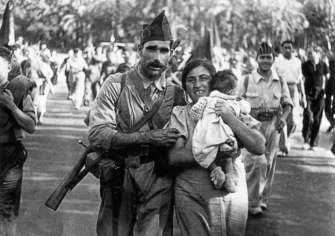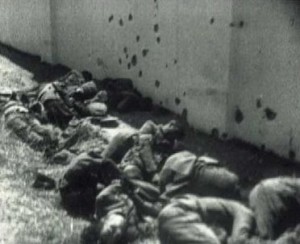

After bloody combats, the resisting forces were overwhelmed: thousands of civilians and militia-men fled in panic across the French border on September 3, 1936. The poorly armed and untrained leftist and Basque nationalist militias fought bravely but could not fend off the rebel push. On August 26, Beorlegi began the assault on Irún. Furthermore, the Nationalists captured the republican commander in Gipuzkoa, Pérez Garmendia. After that, German Ju 52 bombers and other Italian planes bombarded on a daily basis the bordering towns of Hondarribia and Irun, as well as San Sebastián. On August 17, the rebel battleship España, the cruiser Almirante Cervera and the destroyer Velasco arrived at San Sebastián and started to shell the city. Telesforo Monzon, a Basque Nationalist, travelled to Barcelona to seek aid, but he only got 1,000 rifles, and the Basque nationalists confiscated the gold in the local branch of the Bank of Spain to buy weapons in France, but on August 8 the French government closed the frontier.

On August 11 the Nationalists took Tolosa and Beorlegi seized Picoqueta, a key ridge commanding the approach to Irún. Advance on Irun įollowing the failure to relieve the siege of the Nationalists in San Sebastian, the forces of Beorlegui resumed their advance on Irún to cut off the northern provinces of Gipuzkoa, Biscay, Santander and Asturias, from their source of arms and support in France by taking that city. Nevertheless, on 27 July, the Nationalist garrison in San Sebastián surrendered. Two other Nationalist columns advanced on the city from points further west with the intent of cutting it off from Biscay. When word came that the Nationalists in San Sebastián were besieged in the Cuartel de Loyola, Alfonso Beorlegui diverted all his forces westward toward that town in an attempt to relieve the Nationalist garrison. The campaign was diverted from the advance on Irún when the direct route to the town was blocked by the demolition of the bridge at Endarlatsa. The campaign was initially conceived by General Emilio Mola as an advance to Irún, to cut the northern provinces off from France, and to link up with the Nationalist garrison in San Sebastián that was to have seized that city. On August 13, Mola met Franco in Seville and decided to capture San Sebastián and Irún in order to cut the Basques off from the French Border at the western end of the Pyrenees.

Then Francisco Franco sent him large supplies of ammunition and weapons from Italy and Germany via Portugal (600,000 rounds). In late July Mola´s troops suffered a shortage of ammunition (having only 26,000 rounds of ammunition). The campaign of Gipuzkoa was part of the Spanish Civil War, where the Nationalist Army conquered the northern province of Gipuzkoa, held by the Republic. Santuario de Nuestra Señora de la Cabeza.


 0 kommentar(er)
0 kommentar(er)
